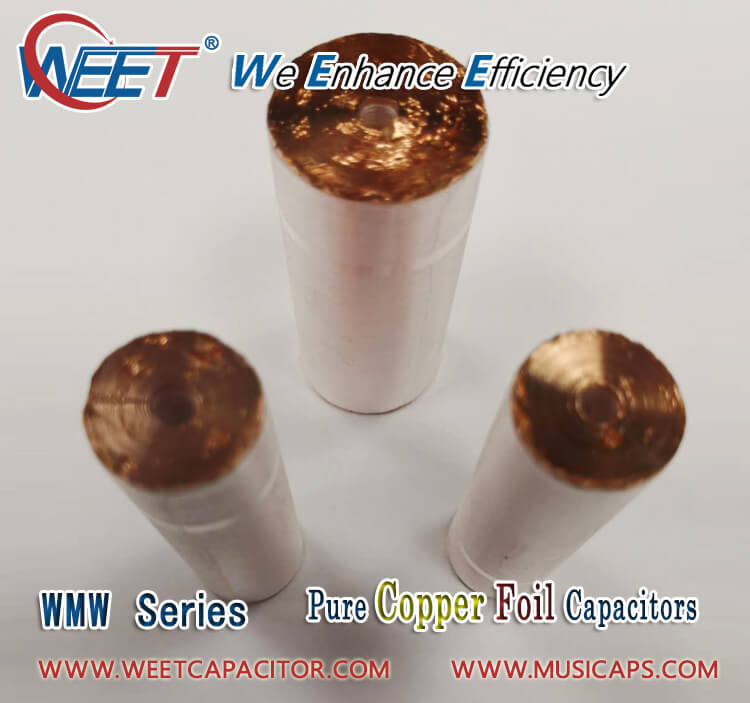WEE Technology Company Limited - WEE are Capacitors Specialist
450V 560uF 85℃ Snap in Aluminum Electrolytic Capacitors
CD293 2000Hrs 85℃ Snap in electrolytic capacitor.
CD293 Series Snap in aluminum electrolytic capacitor, 85℃ Standard Snap in aluminum electrolytic Capacitors
Typical applications include general purpose power electronics, UPS, SMPS, and battery chargers.
Snap Mount Caps usually mount on a PCB (printed circuit board).
Maximum Operating Temperature: : 10V-400V(-40℃~ +85℃); 450V-500V(-25℃ ~ +85℃)
Number of Pins: : 2 Pins, 4 Pins
Voltage : 10V, 25V, 16V, 35V, 50V, 63V, 80V, 100V, 160V, 180V, 200V, 250V, 350V, 400V, 450V,500 V
Cross Reference: Epcos (B41231), Nippon Chemi-Con(SMQ), Nichicon(LS), Panasonic (TS-UQ), Samwha(HC), Kendeil(K26), Yageo(LH), DAEWOO(FHS)

WEE Technology Company Limited - WEE are Capacitors Specialist
WEET Through Hole Single Layer Ceramic Capacitor SLCC 102 472 222 3KV DC ±20% Z5U X7R Dielectric
Ceramic Disc Capacitors 4700pf 3KV Z5U 20% Radial Dipped Ultra High Voltage Capacitor.
A wide variety of ceramic capacitor Condensador cerámico options are available to you, such as rated 1KV, 2KV, 3KV, 6KV, 10KV and 15KV
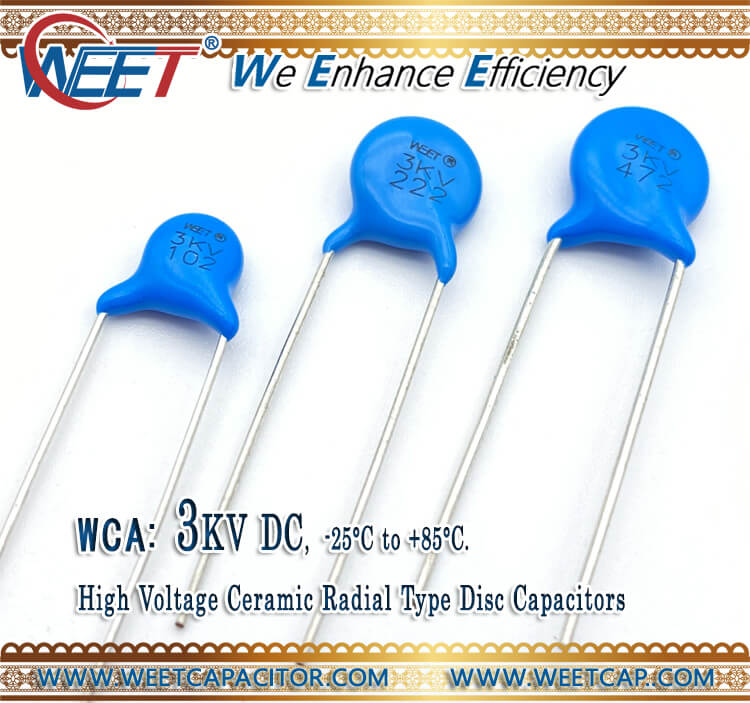
WEE Technology Company Limited - WEE are Capacitors Specialist
High voltage ceramic capacitor has the function of eliminating noise and filtering, and can be used in high voltage environment.
Ceramic capacitor is a kind of capacitor which uses ceramic material as medium, coating a layer of metal film on the surface of ceramic, and then sintered at high temperature as electrode. It is usually used in high stability oscillation circuit as circuit, bypass capacitor and pad capacitor.
The chip capacitor is mainly for high frequency. The high voltage chip capacitor depends on where you use it. The typical function can eliminate high frequency interference. The advantages are as follows:
1. High stability of capacity loss with temperature and frequency
2. The special series structure is suitable for long-term high voltage operation
3. High current climbing rate and suitable for non inductive structure of high current circuit.
WEET Capacitance Characteristics of 2KV High Voltage Radial Ceramic Capacitors
| Material | T.C. | Semiconductors | |||||||
| Type | NPO | SL | Y5P | X7R | Y5E | Y5U | Y5V | Z5U | Z5V |
| Temperature | -25℃~+85℃ | -25℃~+85℃ | -25℃~+85℃ | -55℃~+125℃ | -25℃~+85℃ | -25℃~+85℃ | -25℃~+85℃ | +10℃~+85℃ | +10℃~+85℃ |
| Range | |||||||||
| Rate of change | +250PPM | P350 | ±10% | ±15% | ±4.7% | 22% | 22% | 22% | 22% |
| 0% | -56% | -82% | -56% | -82% | |||||

WEE Technology Company Limited - WEE are Capacitors Specialist
Leaded Ceramic disc blue epoxy reigned capacitors are usually designed and manufactured by coating a ceramic disc with silver contacts on both sides.
To achieve larger capacitance, these devices can be made from multiple or times of layers.
Ceramic disc capacitors are usually through-hole mounting components with two leads and has much advantages due to their small size.
Ceramic capacitors are majorly used in the resonant circuit in transmitter stations.
Ceramic disc capacitors are also used across brush DC motors to minimize RF noise.
To understand a capacitor with code‘103’.
As the first two digits are 10 and the 3rd digit is 3, so the multiplier factor is 1000, the total capacitance value in pF is as follows:
10*1000 = 10000 pF
Similarly, if the capacitor code is 132, the 3rd digit is 2 so the multiplier factor is 100. The capacitance value will be calculated as follows:
13*100 = 1300 pF
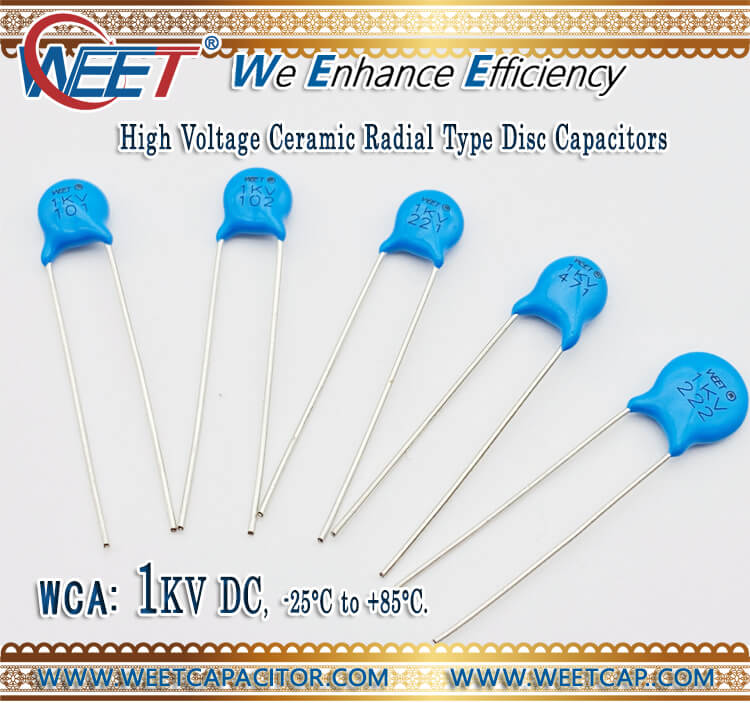
WEE Technology Company Limited - WEE are Capacitors Specialist
WMW Pure Copper Foil and Film Polypropylene Capacitor Cross reference to below brands, welcome your enquiry and testing samples.
Jupiter Copper Foil and Wax Paper Capacitor
Audyn True Copper Cap Copper Foil Capacitor
Angela Copper Foil Paper In Oil Capacitor
Cicada Audiophile Pure Copper Foil with Polypropylene Capacitor
Miflex KFPM and Arizona kaktus Blue Copper Foil Capacitor
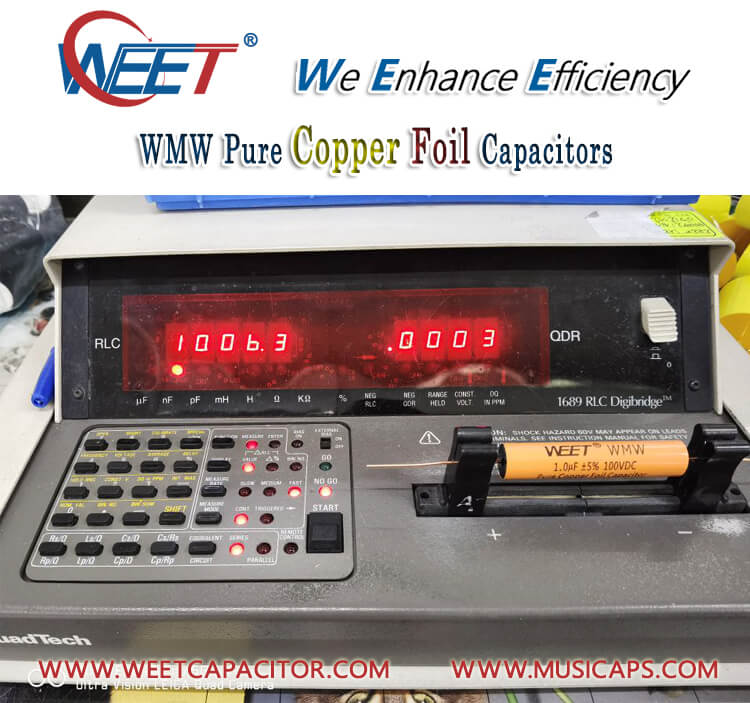
WEE Technology Company Limited - WEE are Capacitors Specialist
Metal film capacitor, structure and characteristics of several common capacitors
Capacitors are commonly used electronic components in electronic equipment. In the previous article, we understand why capacitors can be connected with alternating current and blocking direct current and many kinds of capacitors are also mentioned, but there is no detailed description of various capacitors. Next, we briefly introduce the structure and characteristics of several common capacitors for your reference.
1. Aluminum electrolytic capacitor:
It is made of aluminum cylinder as negative electrode, which is filled with liquid electrolyte and inserted with a bent aluminum strip as cathode. It also needs to be treated by DC voltage to form a layer of oxide film on the positive plate as the medium. It is characterized by large capacity, but large leakage, poor stability and positive and negative polarity. It is suitable for power filter or low frequency circuit. When using, the positive and negative pole should not be reversed.
2. Tantalum niobium electrolytic capacitor:
The anode is made of tantalum or tantalum oxide. Its characteristics are: small volume, large capacity, stable performance, long life, high insulation resistance. Good temperature performance, used in higher requirements of equipment.
3. Ceramic capacitor:
Use ceramics as the medium. Silver coating was sprayed on both sides of the ceramic substrate, and then the silver film was fired as the electrode plate. Its characteristics are: small size, good heat resistance, small loss, high insulation resistance, but small capacity, suitable for high frequency circuit. Ferroelectric ceramics are suitable for low frequency circuits because of their large capacitance, high loss and high temperature coefficient.
4. Mica capacitor:
The electrode plate is made by metal foil or spraying silver layer on mica sheet. The electrode plate is laminated with mica layer by layer, and then it is made by die casting in Bakelite powder or sealing in epoxy resin. It is characterized by small dielectric loss and large insulation resistance. Low temperature coefficient, suitable for high frequency circuit.
5. Film capacitor:
The structure is the same as that of paper capacitor, and the medium is polyester or polystyrene. Polyester film capacitor, with high dielectric constant, small volume, large capacity and good stability, is suitable for bypass capacitor. Polystyrene film capacitor, with low dielectric loss, high insulation resistance and high temperature coefficient, can be used in high frequency circuit.
6. Paper capacitor:
The electrode is made of two pieces of metal foil, sandwiched in a very thin capacitor paper, rolled into a cylindrical or flat cylindrical core, and then sealed in a metal shell or insulating material shell. It is characterized by small volume and large capacity. But the inherent inductance and loss are relatively large, suitable for low-frequency circuit.
7. Metallized paper capacitor:
The structure is basically the same as the paper capacitor. It is covered with a layer of metal film on the capacitor paper to replace the metal foil. It is small in size and large in capacitance. It is generally used in low-frequency circuits.
8. Oil impregnated paper capacitor:
it is to immerse paper capacitor in specially treated oil to enhance its withstand voltage. It is characterized by large capacitance, high voltage withstand, but large volume. In addition, in practical application, firstly, different types of capacitors should be selected according to different uses; secondly, the nominal capacity of capacitors, allowable error, withstand voltage value, leakage resistance and other technical parameters should be considered; thirdly, for electrolytic capacitors with positive and negative polarity, the positive and negative electrodes should not be connected in reverse when welding.
WEE Technology Company Limited - WEE are Capacitors Specialist
Today we would like to share the difference of WMH WMW WMJ and WME to all of our customers, thank you.
WMH and WMW list Metalized PP along with foil...??
---> Yes. Thank you. We call it as foil with PP dielectric insulation, Metallized polypropylene film as medium and electrode
-How are they metalized?
---> WMW Copper foil spliced to polypropylene insulation film layer by layer, WMH Aluminum foil spliced to polypropylene insulation film layer by layer.
-How does the WMJ differ from the WME besides being potted in a Copper tube?
---> Except the external layer, the structure and the PP material are the same
-How are the WMH, WMJ, and WMW terminated on the end of the winding?
---> The end of the winding machine is formed by a winding machine, because the winding machine has a soldering iron head. When it reaches the end, it will burn off the metal, which will turn into plastic. When the plastic is heated, it will be packaged together.
-Do the WMC, WME, and WMF all use the same film, Are all three made with the same welded layer, and lead?
---> Yes, they use same Polypropylene film, but WMC Polypropylene film raw material is from China mainland, WME and WMF Polypropylene film raw material is imported from overseas.
At the same time, the DF factor control standard is different too. The welded layer and lead are the same.
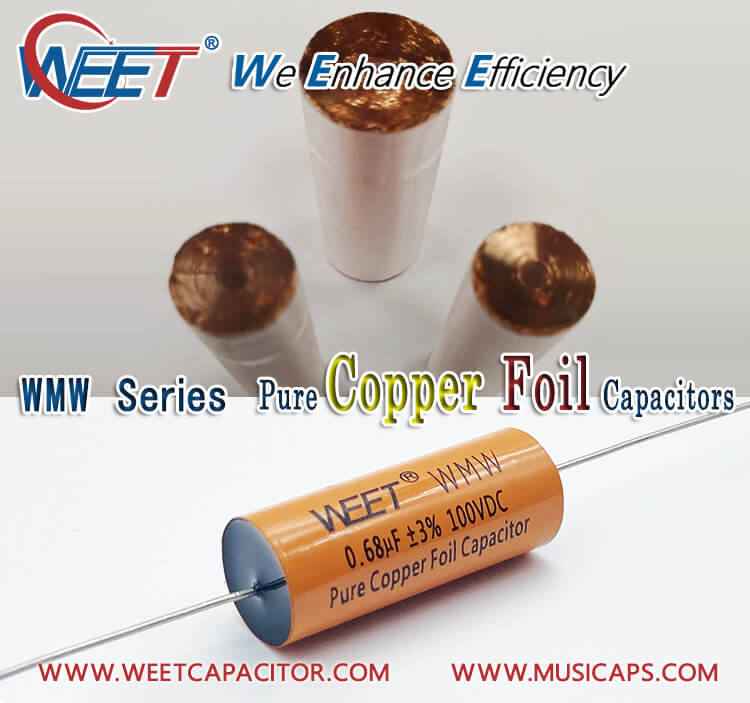
WEE Technology Company Limited - WEE are Capacitors Specialist
1. Structure
Plastic film capacitor is a kind of capacitor with metal foil as electrode, which is overlapped with polyethylene, polypropylene, polystyrene, polycarbonate and other plastic films from both ends, and is wound into a cylindrical structure. According to the type of plastic film, they are called poly (ethyl ester) (Mylar), polypropylene (PP), polystyrene (PS) and polycarbonate.
2. Basic parameters
(1) Rated DC voltage: DC voltage allowed to be applied continuously in the whole temperature range.
(2) Dielectric strength: the voltage that the dielectric of a capacitor can withstand, which is higher than the test voltage.
(3) Rated AC voltage: the effective value of AC voltage that can be continuously applied when the capacitor works under AC voltage.
(4) Test voltage: the voltage applied to the capacitor during the factory type test, generally 1.5 ~ 2 times, lasting for 2 minutes or 500 hours.
3. Function
(1) The function of film capacitance is the same as that of all capacitors, which is to hold the charge.
(2) But compared with other common capacitors, thin film capacitor is a kind of excellent capacitor because of its many excellent characteristics. Its main characteristics are as follows: non polarity, high insulation impedance, excellent frequency characteristics (wide frequency response), and small dielectric loss.
(3) In this case, the short circuit caused by the short circuit of the capacitor is caused by the short circuit of the metal electrode Melting and evaporation to restore insulation, so that the capacitor again restore the role of the capacitor. That is to say, it can heal itself instantly.
4. Working principle
The working principle of thin-film capacitor is the same as that of ordinary capacitor. It stores electric energy by storing charge on the electrode. It is usually used together with inductor to form LC oscillation circuit. The working principle of capacitor is that the charge will move under force in the electric field. When there is a medium between conductors, it will hinder the charge movement and make the charge accumulate on the conductor, resulting in the accumulation and storage of charge.
5. Advantages
Thin film capacitor is a kind of excellent capacitor because of its many excellent characteristics. Its main characteristics are as follows: non polarity, high insulation impedance, excellent frequency characteristics (wide frequency response), and small dielectric loss. Based on the above advantages, thin film capacitors are widely used in analog circuits. Especially in the part of signal cross connection, it is necessary to use capacitors with good frequency characteristics and very low dielectric loss, so as to ensure that the signal will not have too much distortion during transmission. Thin film capacitors are widely used in household appliances, lighting, industry, photovoltaic and wind power generation, new energy vehicles and other fields because of their excellent characteristics, such as good safety, high withstand voltage (single working voltage can even reach thousands of volts), non polarity, high insulation impedance and wide frequency response.

WEE Technology Company Limited - WEE are Capacitors Specialist
I highly recommended WEET copper foil caps. I prefer them to Duelund and have tried both. Far superior to Mundorf in every way, but most especially in the mids and micro details. The WEET copper foil cap is very linear with no part of the sound spectrum highlighted. I find the top of the line Mundorfs a tad boosted in the highs. The Duelunds a tad bumped in the upper mids. The WEET are so smooooth!
You might want to try DIYAudio, but in the "affordable" boutique crossovers my favorites so far:
Clarity MR (now CMR)
Clarity ESA
Mundorf MKP
Mundorf Supremes
WEET WMW copper foil caps
I also like Audyn Truecopper corss to WEET WMW copper foil caps (Bypass values only)
There are two main types of quality caps: metallized, and film-and-foil. The former are cheaper, the latter better: by better, I mean smoother, more refined, more detailed.
Dielectric thickness doesn't matter very much, but metal thickness does. Just about anything thick enough to be wound up on a spool is thick enough for sonics, but a deposited conductor is a different matter.
Construction is also important. The larger the capacitance, the more the cap can suffer from inductance. MIT Multicap have a connection scheme that minimizes this. Duelund has a flat pack topology which is just about optimal.Polypropylene tends to sound pretty good, but compared to styrene, is dull. PTFE (teflon) sounds a little bright compared to styrene. Styrene is, to my mind, the most neutral of the conventional dielectrics. These are the films.For metal, the best is one which connects easily (usually solders easily). Those are silver, copper, and tin. These are the foils.
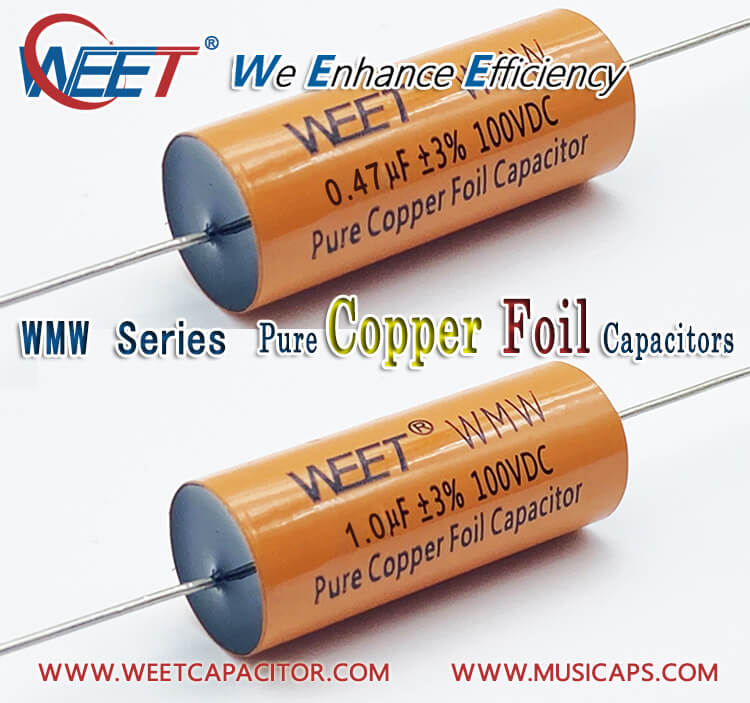
WEE Technology Company Limited - WEE are Capacitors Specialist
What is copper foil?
Copper foil is a key conductive material in lithium-ion battery and printed circuit board. Copper foil is a kind of negative electrolytic material. It is a thin and continuous metal foil deposited on the substrate of circuit board.
Characteristics of copper foil products
Electronic grade copper foil (purity above 99.7%, thickness 5um-105um) is one of the basic materials of electronic industry. With the rapid development of electronic information industry, the use of electronic grade copper foil is increasing,The products are widely used in industrial calculators, communication equipment, QA equipment, lithium-ion batteries, civil television, video recorder, CD player, copier, telephone, heating and cooling air conditioning, automotive electronic components, game machines, etc.
In order to get the best result of audio capacitors, WEET use pure copper foil and MKP materiel to upgrade the performance. Most of the European brands are too expensive to try, but WEET WMW will provide a wonderful alternative choice for you. By single piece at our ebay shop https://www.ebay.com/usr/weetcap
